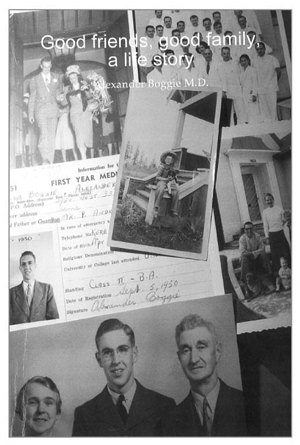Book review: Good Friends, Good Family, a Life Story

Good Friends, Good Family, a Life Story. By Alexander Boggie, MD. Self-published, 2008. Available at UBC Bookstore: www.bookstore.ubc.ca, 1 800 661-3889. ISBN: 281000027009B. Paperback, 123 pages. $10.
Dr Alexander Boggie’s autobiography is written in the third person, avoiding the hint of hubris so easy to convey when the first person is used to record undoubted achievements.
He has successfully combined the very personal story of his family and many friends scattered over three continents with an account of his real contributions to family medicine in BC and to our nascent and now burgeoning medical school and finally pointing the way to the healthy and satisfying retirement to which we all aspire.
His account of hardworking immigrant parents from Scotland in the 1930s, graduation from high school in 1940, wartime service as a radar mechanic with the RCAF in the Far East, consequent university funding from Veterans Affairs, and enrollment in the first cohort of students in our newly formed UBC medical school in 1950 (from which he retired as an associate dean in 1988) is seamlessly interwoven with a detailed account of his deep commitment to family and friends and makes for edifying reading.
Inevitably there have been ups and downs but Al has ridden the waves with courage, wisdom, and insight and now after the sad but inevitable death of his loving wife, Rhoda, he is surrounded by friends, family, successful offspring, and of course by memories of achievement and happiness providing him with “Roses in December” as he exercises in the gym and pool, strides around the golf course, and travels insatiably to keep his contacts.
The memoir is easy to read, short, and free of frills. There are, however, a few errors. On page 53, instead of the usual reference to cities of ancient Rome as Roman they are referred to as Latin, which should be used to refer to language or people. More importantly, it was Dean John McCreary (1959–1972) not McCleary who offered Al a full-time appointment in the new department (was it not then a division?) of family practice in 1969.
Lastly, if I may be allowed a little levity, on page 34 we read of the minus 27 °F temperature in Winnipeg endured by the gallant servicemen returning from the Far East—if that were so one dreads to think what would have happened to the “unmentionables” of the legendary “Brass Monkey” let alone those of Al and his mates who clearly survived the reality of minus 27 °C, which, however dire, did him no lasting harm so that we are now able to enjoy and learn from this valuable memoir.
